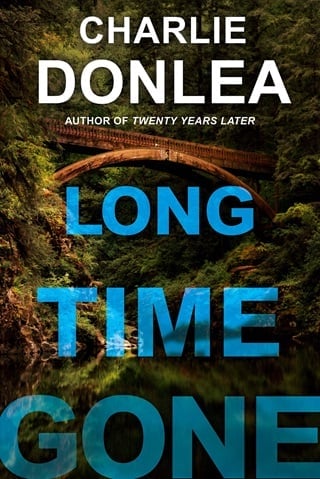CHAPTER 28 - Cedar Creek, Nevada Sunday, July 28, 2024
CHAPTER 28
Cedar Creek, Nevada Sunday, July 28, 2024
ON SUNDAY MORNING SLOAN HEADED BACK TO NORA’S PHOTOGRAPHY studio. Despite the overwhelming reception she had received the day before, and the emotions it brought up, she had managed to refocus her energy once she arrived back to her rental house. Working from the list she and Eric had made, Sloan did an online search for Stella Connelly, Preston Margolis’s previous fiancée, and found on the woman’s law firm’s website a message to clients that Stella had recently taken a leave of absence. A list of other attorneys who were taking over her active cases was offered. Sloan had managed to find Stella Connelly’s cell phone number, but when she called it went straight to voicemail. The timing was strange and Sloan planned to speak with Eric about it next time they met.
She stopped at a coffeehouse in town and purchased two Americanos and a bag of bagels. As she approached Nora’s studio her mind flashed back to the previous afternoon when she’d opened the door to a chorus of cheers from the Margolis family. Sloan was relieved this morning to see the studio empty but for Nora leaning against the counter and scrolling through her phone.
“I grabbed coffee and bagels,” Sloan said when she walked in.
Nora looked up from her phone. “Ah, you’re a godsend. Let’s sit.”
Nora pointed to a table in the corner of the studio where the cardboard boxes were stacked. Nora had unloaded them from the dolly Ellis had wheeled in the previous afternoon.
“I’m excited to look through the rest of the photos,” Nora said. “I haven’t been through these boxes since that summer.”
“All the photos were taken by Annabelle?”
“Yes.”
“The summer . . .”
“She disappeared, yes.”
They sat at the table and forgot about the bagels.
“I told you Annabelle and I became good friends in the short time we knew each other. And that she became fascinated with photography.”
Nora pulled the top off the first box.
“Back then, when I met Annabelle, I had just started my photography business and was trying to make a name for myself.”
Sloan looked around the massive studio that appeared to have every modern photography gadget that existed.
“I’d say you’ve done pretty well.”
“Thanks. But it took years. And much to the chagrin of Tilly and Reid, I never allowed Ellis to bankroll my business. Everything you see is mine, built organically from the ground up.”
“After I got home last night from our sail, I looked you up and did some stalking. You’re pretty much the only gig in town. If people want photos or portraits, they call Nora Margolis Photography.”
“I love the people of this town, the families. I’ve taken photos of some of my clients’ kids when they were born, when they graduated high school and college, when they got married, and then when those kids had kids of their own.”
“It must be special to be a part of their lives like that.”
“It’s my passion.”
Nora placed the lid to the side and pulled the box to the middle of the table.
“I thought you’d like to see these, because in just the few months that Annabelle and I were friends, photography became her passion as well. She was eager for me to teach her everything about the craft. Not for professional purposes. Annabelle was never interested in the business of photography, only the art. And she was good.”
Nora lifted an envelope of pictures from the box and handed it to Sloan. The envelope was thick with glossy 4X6s.
“I gave her one of my cameras as a birthday gift that summer, and she took hundreds of photos with it. Pictures of the town. Pictures of the creek. Pictures of sailboats. Pictures of her and Preston. Pictures of their home being built. And, of course, pictures of you.”
Sloan smiled and felt that same lump forming in her throat at the thought of her birth mother snapping photos of her as an infant.
“You’re obviously too young, but back in the nineties photography started making the transition from film to digital. But the early digital cameras were expensive, and the switch was slow. In ’95 I was still doing most everything on thirty-five-millimeter film. Are you familiar?”
“With film photography? Not really. I’m an iPhone kid.”
Nora smiled. “Back in the day, a roll of film had twenty-four exposures, sometimes more depending on the make and model of the camera and film. There were no smartphones back then. The world didn’t walk around with a camera in their pocket prepared to photograph every event of every day. Back then, you’d use an actual camera, take a bunch of shots, and hope you captured something interesting.”
“Hope?”
Nora smiled. “God, you are young. Yes, hope. You wouldn’t know if you got a good picture until you developed the film, which was what Annabelle loved most about the process. The darkroom.”
“The darkroom? Where you develop photos?”
“Yes. Where negatives on a roll of film are turned into the glossy pictures you’re holding. The film can’t be exposed to ambient light, or the images it holds will be ruined. So you have to go into a ‘dark room,’ ” Nora said, using air quotes, “to develop them. All the pictures you’re holding now, and all the ones filling these boxes, were developed in a darkroom. My darkroom, actually, right here in the studio.”
Nora pointed behind her.
“I still use it every now and then, mostly for nostalgia. I enjoy the process. But Annabelle adored it and couldn’t get enough.”
“Explain it to me.”
Nora smiled, and as she explained the nuances of photography, Sloan got the impression that she missed her old friend.
“You take a photo today with your phone’s camera and get instant feedback. You can tell immediately whether the picture is good or bad. Same thing with modern digital cameras. They have a display screen that will show the photographer if the image is clear or blurry, overexposed or just right, and a hundred other factors that enable the user to decide to save or delete the photo. But back in the day you had to press and pray. You’d look through the viewfinder of the camera, frame the image, press the shutter button, and pray everything turned out perfectly. You wouldn’t know, however, until the film was developed. Most folks used to drop their film off at photo studios or drugstores to be developed. A few days later, their pictures came back, and they’d shuffle through an envelope just like the one you’re holding to see how their photos turned out.”
“Sounds archaic.”
“Compared to today’s technology, it was. But it was also thrilling. For the general consumer, it was exciting to get photos back and see how they turned out. For me, and for Annabelle when she went into the darkroom, it was an obsession. In the darkroom, the images captured on film were projected onto photo paper and only became visible when the paper was submerged in a bath of chemicals. Then, the image slowly came to life, gradually appearing like a living, breathing thing being born. And when the photo was of something special or magnificent, the process was electrifying. Like I said, Annabelle had a passion for the darkroom.”
Nora smiled and shook her head.
“Will you listen to me? I’m boring you to death.”
“Not at all,” Sloan said. “I’m intrigued to hear what my birth mother was so passionate about.”
Nora raised her eyebrows.
“I could show you, if you’re interested.”
“How to develop film?”
Nora nodded. “Yes. In the darkroom.”
“I’d love that.”
“Hold on,” Nora said.
She hurried over to the counter and grabbed a camera.
“Stand up,” Nora said as she walked back to Sloan.
Sloan stood and Nora peered through the viewfinder of the camera and pointed it at Sloan.
“Smile.”
Sloan offered the camera a huge grin and heard the shutter rattle as Nora snapped a photo.
“Come on,” Nora said. “I’ll show you how we used to do it.”
 Fullepub
Fullepub 



